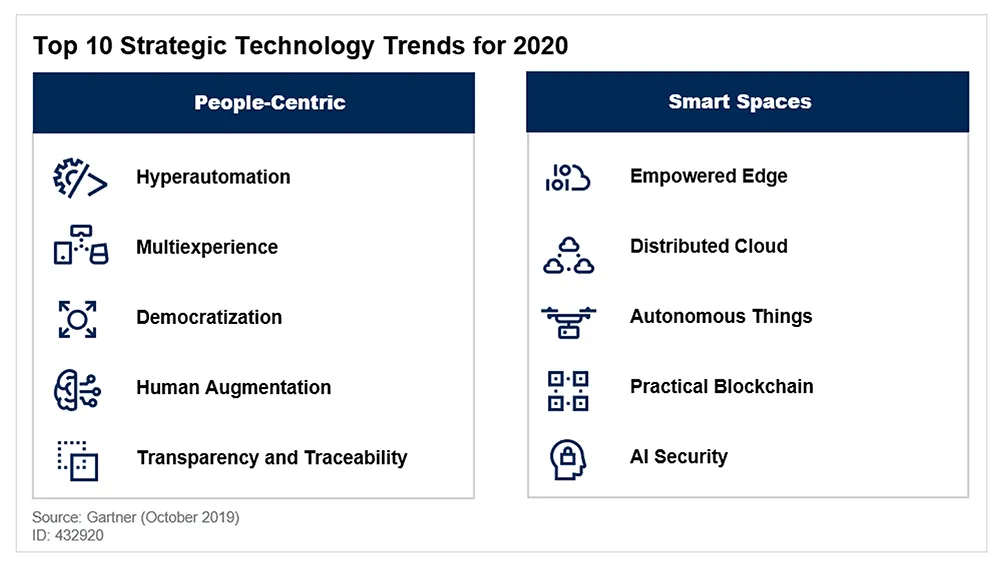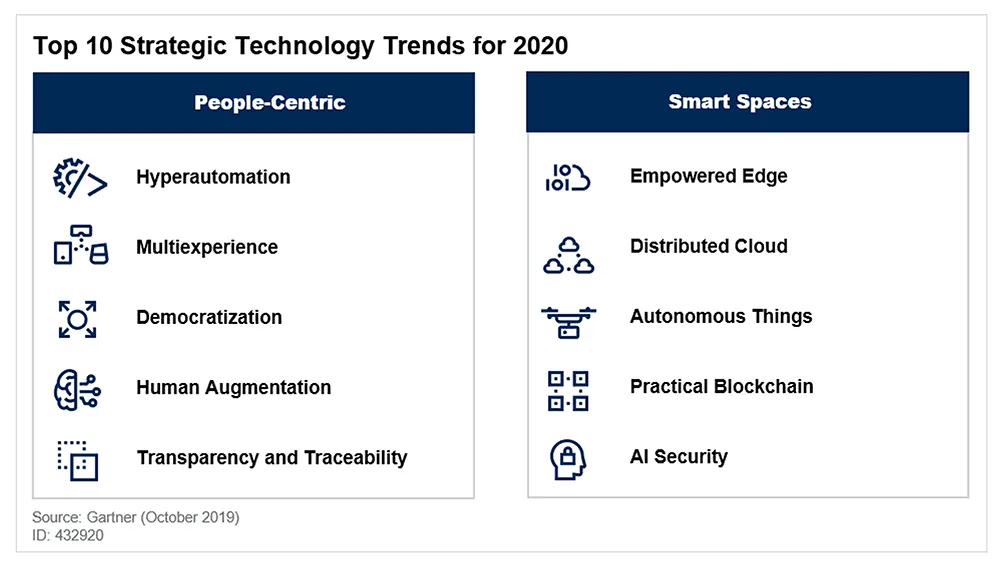Top 10 Strategic Technology Trends for 2020
Blog: AuraQuantic Blog
Technology is the engine that drives digital transformation in every company. However, the digital world evolves very fast and it is simply not enough to adopt technology that meets our current needs, we must also think about our medium- and long-term needs.
Technological trends allow for a medium / long term view for companies to plan which areas to invest their time and effort, thus being part of the organization’s continuous innovation strategy.
Technological TRENDS FOR 2020
It should be noted that technological trends do not contradict the current operation of the company. They show a spectrum of innovation possibilities, providing the potential to create new business opportunities and competitive advantages. So, let’s take a look at the 10 most relevant technological trends for 2020.

1) Hyperautomatization
Automation means using technology to carry out tasks that initially required human intervention. What the Hyperautomatization proposes is an automation of processes with software tools such as BPM and RPA, accompanied by Machine Learning to optimize time, decision-making and the discovery of new activities to be automated.
2) Multiexperience
This trend refers to the improvement of human-machine interfaces, so that users no longer need to understand the technology to use it. It is the technology that understands human needs, adapts to them and takes advantage of all kinds of communication modes based on the human senses. Multiexperience also refers to the inclusion of new sensory experiences (visual, audible, tactile, etc.) such as those offered by VR (Virtual Reality), AR (Augmented Reality) and MR (Mixed Reality).
3) Democratization
This trend is to create simplified models so that all users can enjoy the latest technological experiences, not only as users, but also as application developers, data analysts, etc. Low-Code, No-Code, and advances in Artificial Intelligence play an important role in this field.

4) Human augmentation
This entails using technology to increase human capabilities, whether it be hardware or software. It seeks to enhance vision, hearing, calculation, analysis, decision-making, or many other capabilities. These advances are mainly aimed at facilitating human work.
5) Transparency and traceability
Privacy and digital ethics continue to gain momentum in digitalization as people are increasingly aware of the importance of their data. Organizations that provide technology services must take special care to protect this data and user privacy, especially in environments that begin to use Machine Learning algorithms.
6) Empowered Edge
Edge Computing describes a computer topology in which information processing and content collection and delivery are placed closer to those who consume the information; stemming from the distributed processing philosophy. This aims to keep network traffic and computer processing in a local environment, so as not to saturate the central servers and to reduce latency.
7) Distributed Cloud
Distributed cloud is the distribution of public cloud services to different locations outside the provider’s data center and it is the provider who is responsible for the operation, governance and maintenance of the data. This implies a change from the centralized model of most cloud service providers.
8) Autonomous Systems
Autonomous systems are physical devices that use AI to perform tasks that were previously carried out by people. This includes industrial robots, humanoids, drones and autonomous vehicles, among others. The main areas that are developed in these systems are: perception, interaction, mobility, manipulation, collaboration and autonomy.
9) Practical blockchain
Blockchain is an expandable list of irrevocable transaction records, cryptographically signed and shared by all participants in a network. Each record contains a temporary stamp and a reference link to the previous transaction. Simply speaking, it is the digital implementation of a distributed and unalterable ledger.
Companies are expected to start applying this technology in use cases such as asset tracking, claims processing, identity management, payments, trading, etc.
10) Artificial Intelligence Security
Given the capabilities of Artificial Intelligence, and especially Machine Learning, it is expected that in the next 5 years these technologies will be used to augment analysis and decision-making in a wide range of intelligent environments, from companies to leading cities. The amount of data processed by ML models is immense, and, in many cases, includes personal information. This involves a vast amount of potential points of attack, for example, IoT, microservices, servers, connected personal devices, etc. creating the need for advanced cybersecurity systems.
Attribution
Gartner, Top 10 Strategic Technology Trends for 2020, David Cearley, Nick Jones, David Smith, Brian Burke, Arun Chandrasekaran, CK Lu, 21 October 2019.
Disclaimers
Gartner does not endorse any vendor, product or service depicted in its research publications, and does not advise technology users to select only those vendors with the highest ratings or other designation. Gartner research publications consist of the opinions of Gartner’s research organization and should not be construed as statements of fact. Gartner disclaims all warranties, expressed or implied, with respect to this research, including any warranties of merchantability or fitness for a particular purpose.
The post Top 10 Strategic Technology Trends for 2020 appeared first on AuraPortal.
